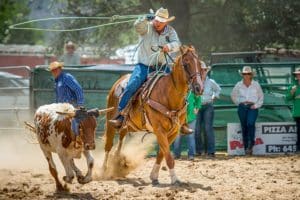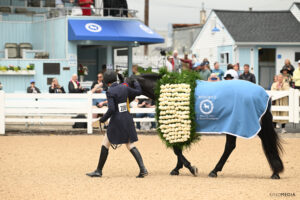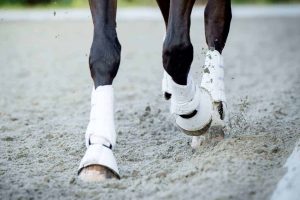Dominance or Foraging Efficiency: Which Causes Hefty Horses?
- Topics: Article, Behavior, Body Condition, Farm and Barn, Hay, Horse Care, Nutrition, Obesity, Pasture and Forages

Horses living in groups experience similar scenarios. In a recent study, British researchers found that “vigilant” individuals interrupt their meals to look around their environment, reducing what scientists refer to as their foraging efficiency. As a result, they tend to have lower body condition scores (BCS) than horses that “carry on munching,” said Christine Nicol, PhD, at the Royal Veterinary College in London, the U.K.
The study’s results challenge a popular belief that horses with the highest body conditions are the most dominant ones, said Nicol. While that’s often true, it’s not always the case—and foraging efficiency might be the explanation.
“Horses with better body condition tend to be more dominant, so there is something in this popular belief,” she said. “But a stronger rule is that horses with a high foraging efficiency are the ones with better body condition. This is a better predictor of high body condition than dominance by itself.”
Foraging Efficiency: Gauging Interruptions During Meals
Foraging efficiency refers to how consistently horses consume their meals, she explained. If they interrupt their feeding time to look around, listen, or move, their foraging efficiency drops.
“Some horses appear to be quite jumpy, showing startle responses or staring into the distance looking at a possible threat on the horizon,” Nicol said, adding that her own mare tends to keep coming out of the barn to check on what the neighboring sheep are doing while she eats.
But vigilance isn’t the only thing reducing foraging efficiency, she added. Interactions between horses can also interrupt meals. Many owners know that lower-ranking horses get interrupted when higher-ranking horses threaten them, making them move to different feeding spots. But to perform threatening behaviors, such as laying back their ears and moving their heads toward another horse, higher-ranking horses experience feeding interruptions, too.
“Horses that are frequently displaced, threatened, or chased by more dominant individuals have low foraging efficiency, but the surprising thing is that some dominant horses that spend a lot of time trying to displace others also have a low foraging efficiency,” said Nicol.
That, plus the fact that some dominant animals are highly vigilant (perhaps watching out for their herd) “could explain why some thin animals may be quite dominant (in a food-related sense),” said Pat Harris, MA, VetMB, PhD, Dipl. ECVCN, MRCVS, equine nutritionist and head of the WALTHAM Equine Studies group based in the U.K.
Observing Behavior and Rank in More Than 100 Horses
In the study, Sarah Giles, a PhD student at the University of Bristol in North Somerset, the U.K., observed more than 100 horses living in 20 groups. She observed them for three continuous hours twice a day as they consumed hay as a group.
The scientists found that the more frequently horses interrupted their meals (stopped eating for up to a minute) to threaten another horse, move away from a horse, pay attention to surroundings, or even scratch themselves, the lower their BCS tended to be. Further, horses with lower foraging efficiencies didn’t seem to make up for lost time by prolonging mealtimes. While there were some correlations with social rank, forage efficiency offered a clearer link with body condition, they said.
This can have consequences on poor body condition, be it a horse that’s too thin or too heavy, said Harris. “From our previous study, dominance seemed to be a significant factor, but it was difficult to know if animals were more dominant because they were obese or more obese because they were dominant,” she said. “This follow-up study suggests, as Professor Nicol says, that it is more linked to forage efficiency rather than dominance per se.”
Managing Obesity or Low Body Weight in Groups
The study results suggest that the horses that eat their meals most calmly tend to get fatter more easily, said Harris. “In very simple terms it seems that those animals that spend more time actually eating are those that may be most likely to be obese within a herd living under the same conditions—such a simple concept, but this study provides some proof,” she explained. “However, obviously other factors, such as metabolic efficiency, as well as feed availability and quality, will also play a part in determining final body condition.”
Knowing this, owners can better manage their group-living horses to help improve BCS, the authors said.
“Watch out for the horses that continue to munch no matter what is going on in the wider world; they may be the ones at greatest risk of putting on too much weight,” Nicol said.
By contrast, if you have a horse that’s too thin, you might need to consider ways to improve that individual’s foraging efficiency. “If you have a jumpy or nervous horse and want to improve its body condition, ensure the horse feels as secure as possible when feeding,” she said. “Reduce social isolation and give the horse a good view of its surroundings so that he or she is not conflicted between eating and being vigilant.”
This can vary according to individual, Harris added. “Some animals may be more secure feeding when a bonded companion, for example, is close by, whereas others may prefer being fed when on their own.”
Overall, it’s a matter of adapting individual needs within a group setting, said Harris. “You need to ensure that the environment suits that individual if you want to improve his or her foraging efficiency,” she said. “Being aware of group dynamics might help manage the weight of certain individuals.”
Owners should check each horse’s body condition regularly and adjust feeding amounts accordingly, Nicol said.
Harris seconds this concept: “Hands-on monitoring through observation and palpation is key.”

Related Articles
Stay on top of the most recent Horse Health news with

















